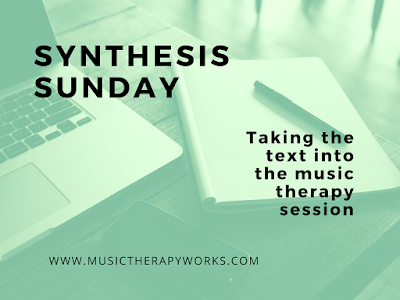Synthesis Sunday: Music, Therapy, and Early Childhood: A Developmental Approach by Elizabeth Schwartz
"Just make music." - Elizabeth Schwartz, page ixMusic, Therapy, and Early Childhood: A Developmental Approach is one of my favorite music therapy texts for working with my population. The book was not written for my particular population - I work with children and adolescents with developmental disabilities and psychiatric concerns - but I find that most of the developmental information transfers nicely into interaction with my clients. It just plain old explains some of the responses that my clients offer to me during their sessions. This has become one of my foundational texts.
Chapter One - Music and young children: How music is experienced
We all have preconceived notions about music and what it could and often should sound like. Schwartz emphasizes that children, especially young children, have no musical labels or artificial ideas about what is "good" music. Music is multi-sensory and just pulls children into interaction with each other and with their own bodies in a way that seems to change around age 12-15. Children soak up the music around them and then internalize it; shaping music, and playing with it until it becomes their own. Children interact with each other in a rhythmic ebb and flow as well. Music is just part of who they are, and children rarely have any sort of self-consciousness about engaging through their voices, bodies, and minds.
My students, all of whom are considered developmentally delayed or disabled, illustrate many of the experiences described in this chapter. I have students who have moved into the adult-type awareness and categorization of music. I have those who are still in the exploration and full immersion phase of musical development. I cherish the opportunities to engage each of my clients in a manner that is appropriate for them - it doesn't happen often these days, but I am getting back into more and more individual interactions.
On page 5, Elizabeth outlines several ways that children experience and create music - self-created, peer-created, home environment music, musical media exposure, environmental music experiences outside the home, and natural music. Of these, I like to work with natural music, self-created music, and peer-created music with my clients. I also tend to use musical media quite a bit in sessions - some of my students identify more strongly with Taylor Swift than with me singing a Taylor Swift song.
I was in a session with a group of students this past week. My intern was leading the therapeutic music experiences (TMEs), leaving me to engage with my clients and observe her interactions as well. I like this phase of music therapy intern development - I am still very much part of the group, but I get to play with my students instead of taking a leadership role. I was sitting next to a relatively new client who demonstrates lots of musicality during sessions. This student does not use verbal communication and does not play instruments, but the student does vocalize throughout the session. Vocalizations often fit within the harmonic structure of the music presented. The student also seems to want musical engagement and will often establish eye contact during silences before vocalizing independent of the musical stimulation present. We were interacting with each other during my intern's TME - just vocalizing together - when the student started singing the melody of The Wheels on the Bus. This was the first replication of a melody that I knew that I had heard from the student. Before this moment, the student had vocalized, but there was no familiar (to me, at least) melody conveyed. I immediately echoed - connection! I now know that the client is absorbing melody as well as engaging through harmony.
When I flip back to the appendix of this text, I find the most valuable part of this book (at least, for me!), the developmental checklist! "Music indicators of early childhood development" sounds like a mouth-full, but it allows me to identify where my clients with their diagnoses fall on the developmental music process. Taking the client I described above, I can start to get an idea of what will be more successful and what is an area of focus for treatment. This student has lots of strengths in the singing portion of the checklist and lots of needs in the area of playing instruments. Music movement is less developed than singing and more developed than playing instruments. I now have an idea of what to do with the student based on the interactions that I've had during sessions.
There are many more things to read and absorb in this text, and I look forward to synthesizing this information into my music therapy practice over the next weeks.
Schwartz, E. (2008). Music, therapy, and early childhood: A developmental approach. Gilsum, NH: Barcelona Publishers.


Comments
Post a Comment